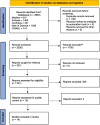Importance of endocrine treatment adherence and persistence in breast cancer survivorship: a systematic review
- PMID: 37403065
- PMCID: PMC10320891
- DOI: 10.1186/s12885-023-11122-8
Importance of endocrine treatment adherence and persistence in breast cancer survivorship: a systematic review
Abstract
Purpose: Adjuvant endocrine treatment is essential for treating luminal subtypes of breast cancer, which constitute 75% of all breast malignancies. However, the detrimental side effects of treatment make it difficult for many patients to complete the guideline-required treatment. Such non-adherence may jeopardize the lifesaving ability of anti-estrogen therapy. In this systematic review, we aimed to assess the consequences of non-adherence and non-persistence from available studies meeting strict statistical and clinical criteria.
Methods: A systematic literature search was performed using several databases, yielding identification of 2,026 studies. After strict selection, 14 studies were eligible for systematic review. The review included studies that examined endocrine treatment non-adherence (patients not taking treatment as prescribed) or non-persistence (patients stopping treatment prematurely), in terms of the effects on event-free survival or overall survival among women with non-metastatic breast cancer.
Results: We identified 10 studies measuring the effects of endocrine treatment non-adherence and non-persistence on event-free survival. Of these studies, seven showed significantly poorer survival for the non-adherent or non-persistent patient groups, with hazard ratios (HRs) ranging from 1.39 (95% CI, 1.07 to 1.53) to 2.44 (95% CI, 1.89 to 3.14). We identified nine studies measuring the effects of endocrine treatment non-adherence and non-persistence on overall survival. Of these studies, seven demonstrated significantly reduced overall survival in the groups with non-adherence and non-persistence, with HRs ranging from 1.26 (95% CI, 1.11 to 1.43) to 2.18 (95% CI, 1.99 to 2.39).
Conclusion: The present systematic review demonstrates that non-adherence and non-persistence to endocrine treatment negatively affect event-free and overall survival. Improved follow-up, with focus on adherence and persistence, is vital for improving health outcomes among patients with non-metastatic breast cancer.
Keywords: Adherence; Breast Cancer; Endocrine Therapy; Persistence; Survival.
© 2023. The Author(s).
Conflict of interest statement
The authors declare that they have no competing interests.
Figures



Similar articles
-
Patient-reported factors associated with adherence to adjuvant endocrine therapy after breast cancer: an integrative review.Breast Cancer Res Treat. 2018 Feb;167(3):615-633. doi: 10.1007/s10549-017-4561-5. Epub 2017 Nov 6. Breast Cancer Res Treat. 2018. PMID: 29110151 Review.
-
Adherence to adjuvant endocrine therapy among breast cancer survivors: a systematic review and meta-synthesis of the qualitative literature using grounded theory.Support Care Cancer. 2020 Nov;28(11):5075-5084. doi: 10.1007/s00520-020-05585-9. Epub 2020 Jun 29. Support Care Cancer. 2020. PMID: 32601852 Free PMC article.
-
Adjuvant therapy use among Appalachian breast cancer survivors.Medicine (Baltimore). 2015 Jul;94(26):e1071. doi: 10.1097/MD.0000000000001071. Medicine (Baltimore). 2015. PMID: 26131828 Free PMC article.
-
Systematic review of real-world studies evaluating the impact of medication non-adherence to endocrine therapies on hard clinical endpoints in patients with non-metastatic breast cancer.Cancer Treat Rev. 2021 Nov;100:102264. doi: 10.1016/j.ctrv.2021.102264. Epub 2021 Jul 31. Cancer Treat Rev. 2021. PMID: 34388473
-
Adjuvant endocrine therapy non-initiation and non-persistence in young women with early-stage breast cancer.Breast Cancer Res Treat. 2023 Feb;197(3):547-558. doi: 10.1007/s10549-022-06810-1. Epub 2022 Nov 27. Breast Cancer Res Treat. 2023. PMID: 36436128 Free PMC article. Clinical Trial.
Cited by
-
Screening and Testing for Homologous Recombination Repair Deficiency (HRD) in Breast Cancer: an Overview of the Current Global Landscape.Curr Oncol Rep. 2024 Aug;26(8):890-903. doi: 10.1007/s11912-024-01560-3. Epub 2024 Jun 1. Curr Oncol Rep. 2024. PMID: 38822929 Free PMC article. Review.
-
Effects of Reishimmune-S, a Fungal Immunomodulatory Peptide Supplement, on the Quality of Life and Circulating Natural Killer Cell Profiles of Patients With Early Breast Cancer Receiving Adjuvant Endocrine Therapy.Integr Cancer Ther. 2024 Jan-Dec;23:15347354241242120. doi: 10.1177/15347354241242120. Integr Cancer Ther. 2024. PMID: 38590244 Free PMC article.
-
The impact of interprofessional collaboration between pharmacists and community health workers on medication adherence: a systematic review.Int J Equity Health. 2025 Feb 28;24(1):58. doi: 10.1186/s12939-025-02415-4. Int J Equity Health. 2025. PMID: 40022158 Free PMC article.
-
Clinical and economic consequences of medication nonadherence: a review of systematic reviews.Front Pharmacol. 2025 Jun 25;16:1570359. doi: 10.3389/fphar.2025.1570359. eCollection 2025. Front Pharmacol. 2025. PMID: 40635744 Free PMC article. Review.
-
Stage at diagnosis and breast cancer-specific mortality in breast cancer patients treated with antidepressants, anxiolytics, and antipsychotics: a population-based cohort study from Northern Ireland.Breast Cancer Res Treat. 2025 Aug;213(1):137-150. doi: 10.1007/s10549-025-07766-8. Epub 2025 Jul 5. Breast Cancer Res Treat. 2025. PMID: 40616690 Free PMC article.
References
-
- CDC: United States Cancer Statistics (USCS), 2022 Available from https://www.cdc.gov/cancer/uscs/about/data-briefs/no25-incidence-relativ.... [cited 2022 apr 29].
-
- American Cancer Society: Breast Cancer Facts & Figures 2019–2020, 2021 Available from https://www.cancer.org/content/dam/cancer-org/research/cancer-facts-and-.... [cited 2022 apr 29].
Publication types
MeSH terms
Substances
LinkOut - more resources
Full Text Sources
Medical

